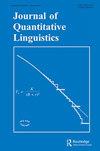A Systemic Dynamics Model of Text Production
IF 1.7
2区 文学
0 LANGUAGE & LINGUISTICS
引用次数: 3
Abstract
ABSTRACT This paper introduces a quantitative model of text as it unfolds in time. The model conceptualizes text as a functional unit of language. This organization can be difficult to identify because it forms complex patterns of linguistic laws, probability and dynamics. These patterns are covert configurations and need complex methods to be investigated. One such method is to draw from qualitative frameworks derived from the quantitative properties of language. Previous studies have shown that covert configurations can be obtained through qualitative frameworks. When dynamics is considered, however, a model of text production including the variable time is needed. This paper therefore aims at addressing this research gap by proposing a dynamics model of text unfolding. It draws from systemic theory and models its categories quantitatively. Time is introduced as variation of choice. The model is applied to a sample of text. Results show how individual choices contribute to text unfolding – describing the amount of meanings at any given moment in text time. In addition, the dynamic accumulation indicates core characteristics of a text, which can be further explored in text behaviour and typology.文本生产的系统动力学模型
本文介绍了一个文本随时间展开的定量模型。该模型将文本概念化为语言的功能单位。这种组织很难识别,因为它形成了语言规律、概率和动态的复杂模式。这些模式是隐蔽的配置,需要复杂的方法来研究。其中一种方法是从语言的定量特性中提取定性框架。以往的研究表明,隐蔽构型可以通过定性框架获得。然而,当考虑动态时,需要一个包含可变时间的文本生成模型。因此,本文旨在通过提出文本展开的动态模型来解决这一研究缺口。它借鉴了系统理论,并对其分类进行了定量建模。时间作为选择的变量被引入。该模型应用于文本样本。结果显示了个人选择如何对文本展开做出贡献——描述文本时间中任何给定时刻的含义数量。此外,动态积累表明了文本的核心特征,这可以在文本行为和类型学中进一步探索。
本文章由计算机程序翻译,如有差异,请以英文原文为准。
求助全文
约1分钟内获得全文
求助全文
来源期刊

Journal of Quantitative Linguistics
Multiple-
CiteScore
2.90
自引率
7.10%
发文量
7
期刊介绍:
The Journal of Quantitative Linguistics is an international forum for the publication and discussion of research on the quantitative characteristics of language and text in an exact mathematical form. This approach, which is of growing interest, opens up important and exciting theoretical perspectives, as well as solutions for a wide range of practical problems such as machine learning or statistical parsing, by introducing into linguistics the methods and models of advanced scientific disciplines such as the natural sciences, economics, and psychology.
 求助内容:
求助内容: 应助结果提醒方式:
应助结果提醒方式:


